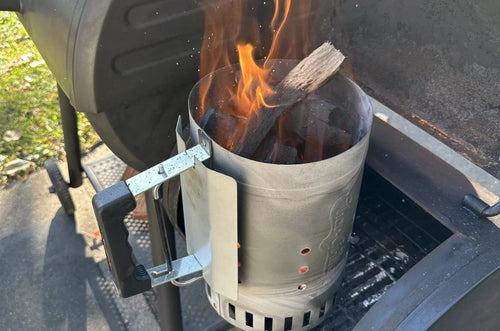Char-Griller Ambassador James Llorens of Certified Creole BBQ breaks down the difference between lump charcoal and briquette charcoal, and which one he prefers.
From James: Charcoal is one of my favorite things about BBQ and have gained a lot of knowledge and information about it over the years using a lot of it. The smell of charcoal means the BBQ is in the air and it's go time.
When I started to BBQ I dove in head first learning everything about charcoal and the differences between the various charcoals. I’ve used my fair share of various types of charcoal such as briquette charcoal, briquette charcoal combined with smoking wood chips, lump charcoal made from various wood from United States, Brazil, Mexico, Cuba and the list goes on. I’ve also tried many briquette and lump charcoal brands we all see at our local stores that sell charcoal and even unknown named brands of charcoal.
The difference between lump charcoal and briquettes is, lump charcoal is the actual wood from the tree is all natural wood carbonized with no chemicals added to it. It’s the reason the pieces of lump charcoal come in different shapes, sizes and is also lighter compared to briquette charcoal.
I like to use the smaller pieces of lump charcoal for short hot n’ fats cooks and the larger pieces for longer low n’ slow cooks. Briquette charcoal is manufactured and molded and made uniform.
Briquettes can have various fillers and chemicals added to it including saw dust, left over wood, lump charcoal dust and it’s also heavier then lump charcoal because the briquette is packed molded.
For the last few years, I’ve used only lump charcoal for my BBQ and it’s because when I was trying out the various charcoal types I preferred lump charcoal over the briquettes because the lump charcoal burned hotter, longer and wasn't as smoky. I also would use more briquettes during a cook than lump charcoal and was more expensive.
Since it’s been awhile since I last briquettes I did an experiment with lump charcoal versus briquettes to compare the two side by side to see how they naturally burn, no cooking involved. I used a named brand hickory briquettes and a name brand premium lump charcoal side by side in separate Char-Griller Charcoal Chimneys.
Ignited them and then released the hot charcoal in two separate Char-Griller Smokin’ Champ Offset Smoker/Grill 1733 & 1624 models. A filled Char-Griller Charcoal Chimney of Hickory Briquettes weighed in at 6.4 pounds and the Premium lump charcoal weighed in at 8.6 pounds.
When igniting them both at the same time, the briquette chimney immediately started to release a lot of dirty smoke and it took about 30 minutes to warm up and the coals didn’t gray/ash over all the way to the top and didn’t flame out and was hot. The lump charcoal warmed up in 20 minutes, they grayed/ashed over and hot flames were coming out and it released very minimal if any smoke at all and was extremely hot.
Released them into the smokers/grills after 30 minutes to allow both chimneys to have the same time to warm up before releasing them. Allowed them to burn for 90 minutes after releasing them into the main grilling area and monitored the temperature throughout, I had all the vents/dampers open on both smokers/grills.
They both hung around 400 ° throughout the burn and the smoke from the smoke stack was minimal, thin and clear. After the 90 minutes the temperature on both started to lower and the briquettes turned into dust with very tiny pieces and pieces of the lump charcoal remained. After shutting down both the smokers/grills by closing all the vents the briquettes turned into all ash with no pieces left and the lump charcoal had small pieces left and had ashes but not as much as the briquettes. I also noticed the color of the ashes from the briquettes is a darker gray and the lump charcoal ashes are a lighter gray.
After this experiment my opinion on briquettes versus lump charcoal remains the same. Lump charcoal is far more superior and better quality especially for quality cooking. It burns cleaner, longer and less ashes. Briquettes in my opinion has too much going on with all the chemicals used to make it, too much dirty smoke and ashes. Hopefully one day a natural briquette can be made but until then it’s lump charcoal all the way for my BBQ.
Major Charcoal tip: Large and well known charcoal companies bag charcoal their charcoal for other well-known BBQ companies under a different label. To find out, look on the back of the charcoal bag in the lower corners to find out who truly bagged and made the charcoal and where it came from. Next time you are at the store, take a look and you will be surprised where some charcoal comes from.

 Flat Iron® Portable 17-inch Gas Griddle
Flat Iron® Portable 17-inch Gas Griddle
 Flat Iron® Premium Gas Griddle
Flat Iron® Premium Gas Griddle
 Flat Iron® Gas Griddle with Lid
Flat Iron® Gas Griddle with Lid


 Sauced and No Sauce Spare Ribs
Sauced and No Sauce Spare Ribs
 Pulled Pork n' Bacon Cheesy Sliders
Pulled Pork n' Bacon Cheesy Sliders
 Smoked Pulled Leg of Lamb
Smoked Pulled Leg of Lamb





